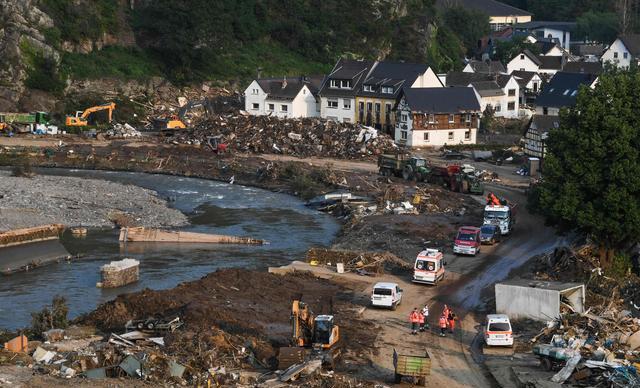
↑Aftermath of a flood photographed on 19 July on the banks of the Altenburg River in Altenburg, Rhineland-Palatinate, western Germany. Picture according to Xinhua News Agency
In recent days, heavy rainfall in the central and western parts of Europe has triggered rare flooding, which has killed at least 195 people in Germany and Belgium. The Netherlands, which borders flood-hit areas in Germany and Belgium, has experienced neither flooded nor reported casualties, despite experiencing extreme rainfall.
In the aftermath of the floods, there has also been a rethink about why Europe's early warning system failed and whether the Netherlands' experience with water control could provide a lesson for other countries to deal with more common extreme rainfall events.
Dutch Water Commission: Fourth Layer of Protection
The overall topographical character of the Netherlands is low and flat. Most of the land is reclaimed from the sea, and most of the altitude is less than 1 meter or even below sea level, and there is still a tendency to sink. With 60 percent of the country at risk of flooding, the Netherlands has been battling the sea and rivers for nearly a thousand years.
According to foreign media reports, the Netherlands has the best water management facilities in the world, including coastal sand dunes and facilities. The government has also adopted other responses, such as lowering riverbeds and expanding river banks to improve river resilience – ensuring there is plenty of room to absorb unexpected amounts of water.
The 1,500 km of man-made fortifications ensured that the Dutch lived in order from floods, and the only function of the general administration behind it, the General Directorate of Public Works and Water Management, was to be responsible for all the water resources in the country, and water committees were elected in various places to be responsible for various water problems, from floods to wastewater.
According to Professor Jaylen Alts, head of the Department of Water and Climate Risks at Vrije Universiteit Amsterdam, the Netherlands had a strong sense of water management a long time ago, and the first water commission was established in Leiden in 1255. He argues that in addition to national governments, provinces and municipalities, the water commissions of the regions provide a "fourth layer of protection" and that the commissions can collect taxes independently, and their operation is not affected by the revenue of the national treasury.
In the Netherlands, Alts said, water issues involve areas such as tourism, industry and construction, leading to possible divergences in water control policies across sectors. He believes that water commissions across the Netherlands are a "glue" that ensures that all parties involved in water issues can communicate. "We can better prepare for the arrival of heavy rain and watch it go." In the post-disaster interview, Mr. Arz said, emphasizing officials' early preparedness and ability to quickly reach out to residents.
Foreign media: There is a "chain break" in Germany's early warning and disaster handling
Foreign media reported that although European countries generally have advanced early warning systems, in practice, there is a gap between meteorological warnings and the actual actions taken by local leaders.
The Copernicus Emergency Management Service, a key component of the Eu's Global Environmental and Safety Monitoring System (COPER), reportedly said it issued more than 25 warnings to specific areas of the Rhine and Meuse rivers through its European Flood Warning System (EFAS) in the days leading up to the flooding of this round of heavy rains. But these early warnings appear to have rarely been passed on to local residents in advance, leading to a complete surprise in the emergency.
German Interior Minister Seehofer said on the 18th that "flood warnings should be issued by local authorities because they have sufficient knowledge of the local area."
The floods exposed a "broken chain" in Germany's early warning and disaster management system. Germany has a "fragmented" system involving local governments in different states and cities, and some local governments are led by different political parties, leading to different reactions.
Red Star News reporter Wang Yalin intern reporter Ding Wen
Edited by Zhang Xun
(Download Red Star News, there are prizes for the newspaper!) )